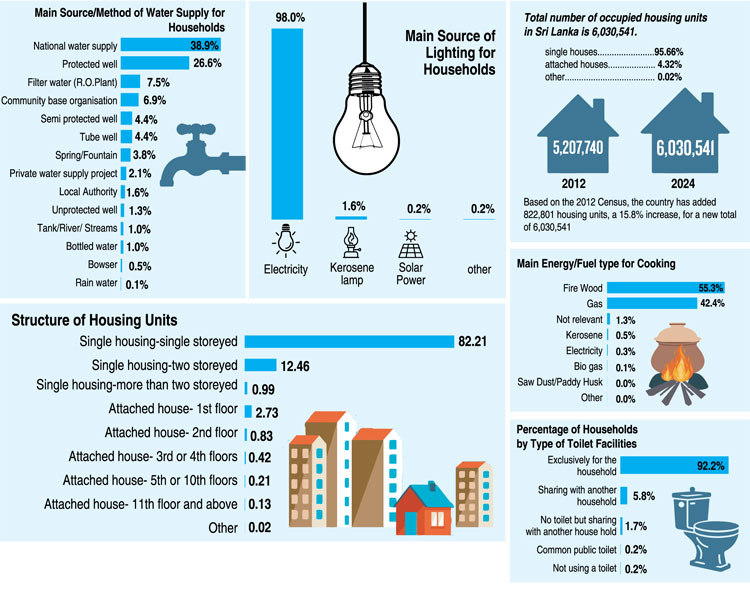News
Uptick in living conditions as houses and housing units on the rise, census reveals
View(s):- Gampaha overtakes Colombo as housing leader
- North/East provinces drive sharpest housing growth as modern amenities expand
By Dilushi Wijesinghe
Sri Lanka’s latest Census of Population and Housing has revealed a significant rise in housing units and steady improvement in living conditions.
According to preliminary findings from the Department of Census and Statistics, the number of occupied housing units has increased to 6,030,541, reflecting a 15.8% increase (822,801 new units) since the last census in 2012.
The Western Province continues to dominate with 28% of the total housing stock, while the Northern Province remains the smallest contributor with 5.3%
The report also confirms a shift in population and housing patterns. Gampaha has now overtaken Colombo as the district with both the highest number of housing units (683,025) and households (688,635).

Colombo's skyline
Single houses continue to define Sri Lanka’s built environment, accounting for 95.7% of the national housing stock. The majority are single-storey homes, though Colombo and other urban areas show a growing number of multi-storey and attached dwellings.
Durable construction has become the norm. Over 90% of homes are now built with long-lasting materials. Walls are almost evenly divided between cement blocks (46.9%) and bricks (46.4%), while asbestos sheets (53.2%) and tiles (33.7%) dominate roofing. Floors are mostly cement (61.5%), with nearly a third using terrazzo, tile, or granite.
Regional preferences reveal the local character of construction. In Polonnaruwa and Kurunegala, brick remains the most used, while Northern districts like Jaffna and Kilinochchi favour cement blocks. Mannar leads the country in tiled roofs (87.3%), and Polonnaruwa has the highest use of asbestos (75.5%). Badulla, meanwhile, stands out for its continued use of non-durable roofing materials (5.7%).
Electricity coverage is almost universal with 97.4% of households connected to the national grid. The figure rises to nearly 100% in most urban areas. Only 1.6% of households–mainly in Batticaloa–still rely on kerosene lamps, while solar power remains rare but emerging, particularly in Colombo where 0.44% of homes use grid-connected solar systems.
When it comes to drinking water, sources vary widely across the country. Nationwide, 38.9% of households depend on piped water supplied by the National Water Supply and Drainage Board. In Colombo, that figure rises sharply to 84.4%, but in districts such as Gampaha, Anuradhapura, and Ratnapura, families continue to rely on protected wells, community projects, or reverse osmosis systems.
Fuel choices for cooking reveal another deep divide. Nationally, 55.3% of households use firewood, a pattern that persists in the central and Uva provinces. In Monaragala, nearly 84% of families cook with firewood, while Colombo’s heavy use of LP gas (85.5%) shows its urban lifestyle.

The 2024 Census counted 6,111,315 households living in the 6.03 million occupied housing units, with an average household size of 3.5 persons. The figure confirms a gradual decline from earlier decades, reflecting smaller family structures, delayed marriage, and increased urban migration.
Access to sanitation continues to improve. 92.2% of households have toilets for their exclusive use, including 62.2% located inside the dwelling. In Colombo, this rises to 90.5%, reflecting dense urban housing with built-in facilities. Only 0.2% of households report no access to any toilet facility, concentrated mainly in parts of the Eastern Province such as Batticaloa (1.9%).
The sharpest housing growth is recorded in the Northern and Eastern provinces, where districts once scarred by conflict and displacement are now seeing tangible recovery. Mullaitivu leads with a 39.2% rise in occupied housing units since 2012, followed by Mannar (37.1%), Kilinochchi (29.3%), and Batticaloa (25.3%).
In contrast, traditionally considered developed districts such as Kegalle, Badulla, and Nuwara Eliya show slower growth, hovering around 8-13%, suggesting demographic stability rather than decline.
An online self-enumeration option (e-Census) was introduced, while printed questionnaires were reserved for special institutions and those without permanent housing.
Conducted from October 2024 to February 2025, the census captured information from all 25 districts, with December 19, 2024, marked as the official “Census Moment” – the reference point for all data collection. Enumeration in the urban areas of Colombo and Gampaha extended into February due to operational complexities.
The best way to say that you found the home of your dreams is by finding it on Hitad.lk. We have listings for apartments for sale or rent in Sri Lanka, no matter what locale you're looking for! Whether you live in Colombo, Galle, Kandy, Matara, Jaffna and more - we've got them all!

